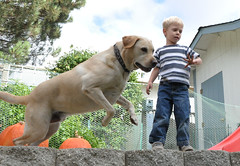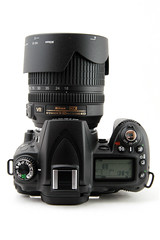The Best Digital SLR of 2008
Finding the best digital SLR of 2008 was not a tough task.
In years past, there have been so many similar cameras that selecting one over the others required in-depth analysis.
But this year, the camera that I liked the best bubbled right to the top due in large part to its ability to take any type of photo.
Many digital SLR cameras have strengths and weaknesses: some are great for action photography, while others are better suited for portraits or landscapes.
It's somewhat rare to find a camera that excels at all types of photography, but the best digital SLR of 2008 does just that.
The only drawback is that you're going to pay a premium for all this functionality - but once you've got it you should have a camera that will last for years to come.
The Contenders
More digital SLR cameras are released in even years vs. odd ones.
While this may seem a bit strange at first, it makes sense once you understand that one of the largest trade shows in the industry - Photokina - only takes place on even years.
Camera makers wait for Photokina to surprise and dazzle the public with their latest and greatest SLRs.
This explains why SO many cameras made their appearance in 2008 - creating a long list of possible candidates for the best digital SLR of 2008.
Here they are:
| CAMERA | RELEASE MONTH | NOTES |
|---|---|---|
| Sony DSLR-A200 | February | A follow-up to the Sony A100, this camera includes minor improvements |
| Pentax K20D | March | Replacing the K10D, this camera is weatherproof and is the first Pentax to include image stabilization |
| Nikon D60 | March | The smallest and lightest Nikon digital SLR |
| Pentax K200D | April | The least expensive SLR available that is weatherproofed |
| Canon Rebel XSi (450D) | April | This 12 megapixel SLR captures incredible images and is compatible with a huge number of lenses |
| Sony DSLR-A350 | April | Includes a 14 megapixel sensor and an LCD that flips out from the camera body |
| Olympus E-420 | May | The smallest and lightest digital SLR available |
| Sony DSLR-A300 | May | A 10 megapixel version of the DSLR-A350 |
| Nikon D700 | July | Very low noise at high ISO and a 51-point autofocus system are just two of the features of this full-frame digital SLR |
| Olympus E-520 | August | Upgrades over the E-510 include an improved LCD display and face-recognition autofocus |
| Canon Rebel XS (1000D) | August | A simpler version of the XSi, the XS is also the smallest and lightest Canon digital SLR |
| Nikon D90 | September | The first digital SLR to capture both video and still images |
| Canon 50D | October | Arriving one year after the 40D, the 50D increases its megapixels to 15 and includes automatic adjustments for challenging light |
| Sony DSLR-A900 | September | This full-frame SLR includes a whopping 24.6 megapixel sensor along with built-in image stabilization |
| Canon 5D Mark II | November | The second digital SLR to capture video, the 5D has a full-frame sensor (like the Nikon D700 and Sony A900) |
And The Winner Is...
My pick for the best digital SLR of 2008 is the Nikon D90.
While it initially captured my attention because of its ability to capture video (which opens up a WHOLE new way to create lasting moments) what really sold me on this camera was its exceptional image quality, even when you boost the ISO (more on this in a moment).
I was also impressed with the little "extras" packed into this camera, making it extremely versatile and able to satisfy the needs of a wide variety of photographers.
Some of the extras include precise control over image toning (sepia, cyanotype, etc.), the ability to take multiple exposures, and an impressive built-in flash that also can act as a wireless trigger for other external Nikon flash units.
Finally, there's something quite tangible about the appeal of the D90 - it just feels great in your hand. Nikon clearly thought a lot about the ergonomics of the camera, because the balance and heft of the camera are just right.
Video, Low Noise and Flash
Just because I've selected the D90 as the best digital SLR of 2008 doesn't mean the other cameras don't have a lot to offer - they do.
In fact, the Canon digital Rebel line has been camped out at the top of the best-seller lists for years now, a clear indication of the popularity and quality of those cameras.
However, the D90 does something that no other digital SLR before has been capable of: it captures video.
When I am sifting through the piles of different cameras released each year in an effort to find the one that really stands out, I am looking for some type of special innovation in addition to great picture quality.
The video option on the D90 is just that - a ground-breaking feature that I'm sure will soon find it way into many other digital SLR cameras.
The video does have limitations (duration is limited and focus is manual only) so don't toss out your trusty video camera just yet.
The Nikon D90 is part of a new breed of cameras, ones which are able to capture sound and motion if the moment calls for it but are also adept at capturing exceptional still images.
Image quality is also what sets the D90 apart from many of the other cameras released this year. If the video feature were paired with sub-par still image quality, then the video mode would just be a novelty item and nothing else.
But the D90 is capable of capturing exceptional images, filled with color, contrast and clarity.
If you're not happy with the way your images are turning out, every image setting can be calibrated and customized, something that you can't do with lesser cameras (even Nikon's own D60).
Dim Light? No Problem
Cameras with built-in image stabilization (Sony DSLR-A200, Sony DSLR-A300, DSLR-A350, Pentax K20D, Olympus E-520) are appealing since they are able to reduce blurry images caused by camera shake.
But there's one catch: your subject can't be moving.
Image stabilization will improve the clarity of images taken in low light, so long as the subject is static (like a landscape).
The only way to capture clear shots of moving subjects in dim light (without flash) is to increase the ISO setting on the camera, making the sensor absorb light faster.
The high ISO setting allows you to use faster shutter speeds, which will freeze the motion of even the most energetic subject.
The only problem with some digital SLR cameras (and every compact camera on the market) is that increasing the ISO also reduces the image quality - adding colored dots or "noise" to your photos.
Some cameras suppress high ISO noise better than others, and the Nikon D90 excels at it.
The ability to take shots at ISO 800 that are virtually noise-free opens up a world of photographic possibilities, especially if you love taking pictures in relatively dim available light.
Lighting With Flash
When I first started taking photos with a digital SLR, I rarely used flash. I didn't like the look that it created in my photos, and I preferred the color and quality of natural light.
Now that I've learned more about flash photography, I've developed a real appreciation for photographers who leverage it all the time.
While advanced flash photography is certainly possible with every camera that I listed above, there's something quite appealing about the simplicity of the Nikon flash system.
Nikon's acronym for it is CLS, which stands for Creative Lighting System.
Creative marketing names aside, Nikon's CLS allows you to control multiple flash units wirelessly using the flash built into the D90 (and a few other very expensive Nikon SLRs).
The only thing that you need in addition to the camera is an external flash unit like the Nikon SB-600, SB-800 or SB-900.
The best part about Nikon's CLS is that you adjust the power output from each flash unit without ever leaving the camera. If you're not happy about the volume of light being put out by your external flash units you can either increase it or decrease it just by using a menu setting on the D90.
The built-in flash on the D90 sends a control signal to the external flashes so that they know just how much light to put out.
Comparative Analysis
So what makes the D90 my pick as the best digital SLR of 2008?
After all, there are some fairly nice competing cameras in the list above and any one of them can be used to capture incredible images.
For me, it comes down to one small word: versatility.
The D90 really is a go-anywhere snap-anything type of camera:
- With an 11-point autofocus system and a 4.5 photo-per-second continuous speed, it works quite well for action photography
- A slew of customized color controls help landscape photographers capture mother nature in all her glory
- Taking photos of moving subjects in dim light is possible by boosting the ISO up to 800 or 1600 (with minimal loss of image quality)
- Multiple off camera wireless flashes are easy to activate and control
While other cameras suffer from a small limitation here or there (not fast enough for action, too big and heavy to carry around, minimal lens compatibility, etc.) the D90 has no such boundaries.
No, it's not nearly as small and light as the Nikon D60, Olympus E-420 or the Canon XSi but those cameras can be difficult to hold comfortably if you have large hands or long fingers.
Even though the D90's LCD screen is fixed in place (unlike the Sony DSLR-A300 and DSLR-A350) its 920,000 pixels make reading menus and checking focus (when reviewing images) a snap.
Only the Pentax K200D and K20D have an advantage - weatherproofing - but the degree of advantage depends a lot on where you intend to take pictures. If you're a fair-weather photographer, the D90 will work just fine.
Of course, one huge advantage the Nikon D90 has over virtually every other digital SLR released this year is the ability to capture videos.
Only one other camera in the list can capture video - the Canon EOS 5D Mark II - but since the Canon is aimed more at the professional market, it comes with a price tag to match: almost three times as much as the D90.
Attractive pricing is also why the D90 wins out for me over some other exceptional alternatives like the full-frame Nikon D700 and the Sony DSLR-A900.
While you can pick up a D90 body only for less than $1,000, both the D700 and A900 will run you well over $2,000.
Summary
Even though I feel the Nikon D90 is the best digital SLR of 2008, it still might not be the best camera for you.
Many factors will come into play as you try to make your final decision about which camera to buy.
Even though the D90 is inexpensive relative to the other SLR with video, it is still priced well above many other models (and is way beyond many people's budgets for a camera).
Furthermore, operating the D90 is not exactly easy if it's the first SLR you've ever had in your hands.
In an effort to make the camera appealing to photographers with more advanced skills, Nikon added dedicated buttons for the camera settings that are changed most often (exposure compensation, ISO, white balance, image quality, drive mode, etc.)
What this means for a beginning SLR photographer is that you are faced with a camera that is packed with 16 different buttons, each one with a different control.
Some will see this as a learning opportunity and others will just be overwhelmed.
Where you fall depends entirely on your level of knowledge about digital SLR features and functions, and your comfort level with gadgets.
So long as you're not intimidated by technology, you can set the camera to full AUTO mode to begin with, and then explore each individual custom setting as time permits (which I encourage, since you're not leveraging the full potential of the camera otherwise).
Related Links
| Digital SLR Home | Nikon D90 Guide |

|






